Quasi-Static Lineshape Theory for Rydberg Excitations in High-Density Media
Abstract
1. Introduction
2. Theoretical Approach and Methodology
2.1. Quasi-Static Lineshape Theory
2.2. Rydberg Excitation in a Dense Environment
2.3. Simulating Lineshape of Rydberg Excitation in a Dense Environment
- We choose the distance of the Rydberg excitation from the center of the trap. The probability of a radial distance should be proportional both to the density at and the surface area of a sphere of radius . Thus, we use as a radial probability distribution where and normalizes the distribution to 1.
- We choose the number of nearby perturber atoms N. We define “nearby” to mean within of the Rydberg core in atomic units, where is the effective principal quantum number of the Rydberg state. Beyond this point, the electronic wavefunction is negligible. We assume so that the nearby density is roughly uniform. Thus, the expected number of nearby perturbers is , and, according to a Poisson distribution, the probability of N nearby perturbers is .
- We choose the distance r of each perturber from the Rydberg core. Since the nearby density is constant, this is a uniform distribution in space, or one proportional to . This can be normalized as where .
- The total effect of perturbers on the excitation energy is then , where the sum runs over all perturbers. This gives the detuning for this Rydberg excitation.
3. Results and Discussion
3.1. Determining Effective Scattering Lengths
3.2. Determining BEC Density Parameters
3.3. Accuracy of the Quasi-Static Simulations
- To determine the random error, 10 lineshapes of excitations each are generated for each n. The average of lineshapes gives lineshape A, and their standard deviation gives the random error.
- To infer uncertainty due to the intrinsic errors attached to the effective scattering lengths, two lineshapes and of excitations each were generated for each n, calculating detunings using the scattering length lower and upper bounds, respectively. Both and used the same perturber arrangements as the excitations of lineshape A. Two new lineshapes, and , are defined as and without being normalized. Then , wherever positive, is an additional source of lower uncertainty, and , wherever positive, is an additional source of upper uncertainty.
3.4. Roles of the Rydberg Core–Perturber Interaction and the Thermal Fraction
4. Summary and Conclusions
Author Contributions
Funding
Data Availability Statement
Acknowledgments
Conflicts of Interest
References
- Amaldi, E.; Segrè, E. Effetto della Pressione Sui Termini Elevati Degli Alcalini. Nuovo C. 2008, 11, 145. [Google Scholar] [CrossRef]
- Fermi, E. Sopra lo Spostamento per Pressione delle Righe Elevate delle Serie Spettrali. Nuovo C. 2008, 11, 157. [Google Scholar] [CrossRef]
- Greene, C.H.; Dickinson, A.S.; Sadeghpour, H.R. Creation of Polar and Nonpolar Ultra-Long-Range Rydberg Molecules. Phys. Rev. Lett. 2000, 85, 2458–2461. [Google Scholar] [CrossRef] [PubMed]
- Hamilton, E.L.; Greene, C.H.; Sadeghpour, H.R. Shape-resonance-induced long-range molecular Rydberg states. J. Phys. B At. Mol. Opt. Phys. 2002, 35, L199–L206. [Google Scholar] [CrossRef]
- Chibisov, M.I.; Khuskivadze, A.A.; Fabrikant, I.I. Energies and dipole moments of long-range molecular Rydberg states. J. Phys. B At. Mol. Opt. Phys. 2002, 35, L193–L198. [Google Scholar] [CrossRef]
- Shaffer, J.P.; Rittenhouse, S.T.; Sadeghpour, H.R. Ultracold Rydberg molecules. Nat. Commun. 2018, 9, 1965. [Google Scholar] [CrossRef]
- Fey, C.; Hummel, F.; Schmelcher, P. Ultralong-range Rydberg molecules. Mol. Phys. 2020, 118, e1679401. [Google Scholar] [CrossRef]
- Bendkowsky, V.; Butscher, B.; Nipper, J.; Shaffer, J.P.; Löw, R.; Pfau, T. Observation of ultralong-range Rydberg molecules. Nature 2009, 458, 1005–1008. [Google Scholar] [CrossRef]
- Booth, D.; Rittenhouse, S.T.; Yang, J.; Sadeghpour, H.R.; Shaffer, J.P. Production of trilobite Rydberg molecule dimers with kilo-Debye permanent electric dipole moments. Science 2015, 348, 99–102. [Google Scholar] [CrossRef]
- Niederprüm, T.; Thomas, O.; Eichert, T.; Lippe, C.; Pérez-Ríos, J.; Greene, C.H.; Ott, H. Observation of pendular butterfly Rydberg molecules. Nat. Commun. 2016, 7, 12820. [Google Scholar] [CrossRef] [PubMed]
- Gaj, A.; Krupp, A.T.; Balewski, J.B.; Löw, R.; Hofferberth, S.; Pfau, T. From molecular spectra to a density shift in dense Rydberg gases. Nat. Commun. 2014, 5, 4546. [Google Scholar] [CrossRef] [PubMed]
- Anderson, D.A.; Miller, S.A.; Raithel, G. Photoassociation of Long-Range nD Rydberg Molecules. Phys. Rev. Lett. 2014, 112, 163201. [Google Scholar] [CrossRef] [PubMed]
- Bellos, M.A.; Carollo, R.; Banerjee, J.; Eyler, E.E.; Gould, P.L.; Stwalley, W.C. Excitation of Weakly Bound Molecules to Trilobitelike Rydberg States. Phys. Rev. Lett. 2013, 111, 053001. [Google Scholar] [CrossRef] [PubMed]
- Böttcher, F.; Gaj, A.; Westphal, K.M.; Schlagmüller, M.; Kleinbach, K.S.; Löw, R.; Liebisch, T.C.; Pfau, T.; Hofferberth, S. Observation of mixed singlet-triplet Rb2 Rydberg molecules. Phys. Rev. A 2016, 93, 032512. [Google Scholar] [CrossRef]
- DeSalvo, B.J.; Aman, J.A.; Dunning, F.B.; Killian, T.C.; Sadeghpour, H.R.; Yoshida, S.; Burgdörfer, J. Ultra-long-range Rydberg molecules in a divalent atomic system. Phys. Rev. A 2015, 92, 031403. [Google Scholar] [CrossRef]
- Li, W.; Pohl, T.; Rost, J.M.; Rittenhouse, S.T.; Sadeghpour, H.R.; Nipper, J.; Butscher, B.; Balewski, J.B.; Bendkowsky, V.; Löw, R.; et al. A Homonuclear Molecule with a Permanent Electric Dipole Moment. Science 2011, 334, 1110–1114. [Google Scholar] [CrossRef] [PubMed]
- Tallant, J.; Rittenhouse, S.T.; Booth, D.; Sadeghpour, H.R.; Shaffer, J.P. Observation of Blueshifted Ultralong-Range Cs2 Rydberg Molecules. Phys. Rev. Lett. 2012, 109, 173202. [Google Scholar] [CrossRef] [PubMed]
- Camargo, F.; Schmidt, R.; Whalen, J.D.; Ding, R.; Woehl, G.; Yoshida, S.; Burgdörfer, J.; Dunning, F.B.; Sadeghpour, H.R.; Demler, E.; et al. Creation of Rydberg Polarons in a Bose Gas. Phys. Rev. Lett. 2018, 120, 083401. [Google Scholar] [CrossRef]
- Schmidt, R.; Whalen, J.D.; Ding, R.; Camargo, F.; Woehl, G.; Yoshida, S.; Burgdörfer, J.; Dunning, F.B.; Demler, E.; Sadeghpour, H.R.; et al. Theory of excitation of Rydberg polarons in an atomic quantum gas. Phys. Rev. A 2018, 97, 022707. [Google Scholar] [CrossRef]
- Schlagmüller, M.; Liebisch, T.C.; Engel, F.; Kleinbach, K.S.; Böttcher, F.; Hermann, U.; Westphal, K.M.; Gaj, A.; Löw, R.; Hofferberth, S.; et al. Ultracold Chemical Reactions of a Single Rydberg Atom in a Dense Gas. Phys. Rev. X 2016, 6, 031020. [Google Scholar] [CrossRef]
- Kanungo, S.K.; Whalen, J.D.; Lu, Y.; Killian, T.C.; Dunning, F.B.; Yoshida, S.; Burgdörfer, J. Loss rates for high-n,49≲n≲150,5sns (3S1) Rydberg atoms excited in an 84Sr Bose-Einstein condensate. Phys. Rev. A 2020, 102, 063317. [Google Scholar] [CrossRef]
- Dunning, F.B.; Buathong, S. Collisions of Rydberg atoms with neutral targets. Int. Rev. Phys. Chem. 2018, 37, 287–328. [Google Scholar] [CrossRef]
- Geppert, P.; Althön, M.; Fichtner, D.; Ott, H. Diffusive-like redistribution in state-changing collisions between Rydberg atoms and ground state atoms. Nat. Commun. 2021, 12, 3900. [Google Scholar] [CrossRef] [PubMed]
- Pérez-Ríos, J.; Eiles, M.T.; Greene, C.H. Mapping trilobite state signatures in atomic hydrogen. J. Phys. B At. Mol. Opt. Phys. 2016, 49, 14LT01. [Google Scholar] [CrossRef]
- Schlagmüller, M.; Liebisch, T.C.; Nguyen, H.; Lochead, G.; Engel, F.; Böttcher, F.; Westphal, K.M.; Kleinbach, K.S.; Löw, R.; Hofferberth, S.; et al. Probing an Electron Scattering Resonance using Rydberg Molecules within a Dense and Ultracold Gas. Phys. Rev. Lett. 2016, 116, 053001. [Google Scholar] [CrossRef]
- Liebisch, T.C.; Schlagmüller, M.; Engel, F.; Nguyen, H.; Balewski, J.; Lochead, G.; Böttcher, F.; Westphal, K.M.; Kleinbach, K.S.; Schmid, T.; et al. Controlling Rydberg atom excitations in dense background gases. J. Phys. B At. Mol. Opt. Phys. 2016, 49, 182001. [Google Scholar] [CrossRef]
- Lippe, C.; Eichert, T.; Thomas, O.; Niederprüm, T.; Ott, H. Excitation of Rydberg Molecules in Ultracold Quantum Gases. Phys. Status Solidi 2019, 256, 1800654. [Google Scholar] [CrossRef]
- Allard, N.; Kielkopf, J. The effect of neutral nonresonant collisions on atomic spectral lines. Rev. Mod. Phys. 1982, 54, 1103–1182. [Google Scholar] [CrossRef]
- Kuhn, H.; London, F. XCII. Limitation of the potential theory of the broadening of spectral lines. Lond. Edinb. Dublin Philos. Mag. J. Sci. 1934, 18, 983–987. [Google Scholar] [CrossRef]
- Kuhn, H. Pressure Broadening of Spectral Lines and van der Waals Forces. I. Influence of Argon on the Mercury Resonance Line. Proc. R. Soc. Lond. Ser. A Math. Phys. Sci. 1937, 158, 212–229. [Google Scholar]
- Kuhn, H. Pressure Broadening of Spectral Lines and van der Waals Forces. II. Continuous Broadening and Discrete Bands in Pure Mercury Vapour. Proc. R. Soc. Lond. Ser. A Math. Phys. Sci. 1937, 158, 230–241. [Google Scholar]
- Kuhn, H. Pressure Shift of Spectral Lines. Phys. Rev. 1937, 52, 133. [Google Scholar] [CrossRef]
- Margenau, H. Pressure Shift and Broadening of Spectral Lines. Phys. Rev. 1932, 40, 387–408. [Google Scholar] [CrossRef]
- Margenau, H. Theory of Pressure Effects of Foreign Gases on Spectral Lines. Phys. Rev. 1935, 48, 755–765. [Google Scholar] [CrossRef]
- Margenau, H.; Watson, W.W. Pressure Effects on Spectral Lines. Rev. Mod. Phys. 1936, 8, 22–53. [Google Scholar] [CrossRef]
- Margenau, H. Statistical Theory of Pressure Broadening. Phys. Rev. 1951, 82, 156–158. [Google Scholar] [CrossRef]
- Omont, A. On the theory of collisions of atoms in rydberg states with neutral particles. J. Phys. Fr. 1977, 38, 1343–1359. [Google Scholar] [CrossRef]
- Bolda, E.L.; Tiesinga, E.; Julienne, P.S. Effective-scattering-length model of ultracold atomic collisions and Feshbach resonances in tight harmonic traps. Phys. Rev. A 2002, 66, 013403. [Google Scholar] [CrossRef]
- Pethick, C.; Smith, H. Bose-Einstein Condensation in Dilute Gases; Cambridge University Press: Cambridge, UK, 2002. [Google Scholar]
- Martinez de Escobar, Y.N.; Mickelson, P.G.; Pellegrini, P.; Nagel, S.B.; Traverso, A.; Yan, M.; Côté, R.; Killian, T.C. Two-photon photoassociative spectroscopy of ultracold 88Sr. Phys. Rev. A 2008, 78, 062708. [Google Scholar] [CrossRef]
- Schwartz, H.L.; Miller, T.M.; Bederson, B. Measurement of the static electric dipole polarizabilities of barium and strontium. Phys. Rev. A 1974, 10, 1924–1926. [Google Scholar] [CrossRef]
- Avni, Y. Energy spectra of X-ray clusters of galaxies. Astrophys. J. 1976, 210, 642–646. [Google Scholar] [CrossRef]
- Giannakeas, P.; Eiles, M.T.; Robicheaux, F.; Rost, J.M. Generalized local frame-transformation theory for ultralong-range Rydberg molecules. Phys. Rev. A 2020, 102, 033315. [Google Scholar] [CrossRef]
- Whalen, J.D.; Camargo, F.; Ding, R.; Killian, T.C.; Dunning, F.B.; Pérez-Ríos, J.; Yoshida, S.; Burgdörfer, J. Lifetimes of ultralong-range strontium Rydberg molecules in a dense Bose-Einstein condensate. Phys. Rev. A 2017, 96, 042702. [Google Scholar] [CrossRef]
- Lebedev, V.S. Ionization of Rydberg atoms by neutral particles. I. Mechanism of the perturber-quasifree-electron scattering. J. Phys. B At. Mol. Opt. Phys. 1991, 24, 1977. [Google Scholar] [CrossRef]
- Lebedev, V.S. Ionization of Rydberg atoms by neutral particles. II. Mechanisms of the perturber-core scattering. J. Phys. B At. Mol. Opt. Phys. 1991, 24, 1993. [Google Scholar] [CrossRef]
- Zuber, N.; Anasuri, V.S.V.; Berngruber, M.; Zou, Y.Q.; Meinert, F.; Löw, R.; Pfau, T. Observation of a molecular bond between ions and Rydberg atoms. Nature 2022, 605, 453–456. [Google Scholar] [CrossRef]
- Deiß, M.; Haze, S.; Hecker Denschlag, J. Long-Range Atom–Ion Rydberg Molecule: A Novel Molecular Binding Mechanism. Atoms 2021, 9, 34. [Google Scholar] [CrossRef]
- Duspayev, A.; Han, X.; Viray, M.A.; Ma, L.; Zhao, J.; Raithel, G. Long-range Rydberg-atom–ion molecules of Rb and Cs. Phys. Rev. Res. 2021, 3, 023114. [Google Scholar] [CrossRef]
- Secker, T.; Ewald, N.; Joger, J.; Fürst, H.; Feldker, T.; Gerritsma, R. Trapped Ions in Rydberg-Dressed Atomic Gases. Phys. Rev. Lett. 2017, 118, 263201. [Google Scholar] [CrossRef]
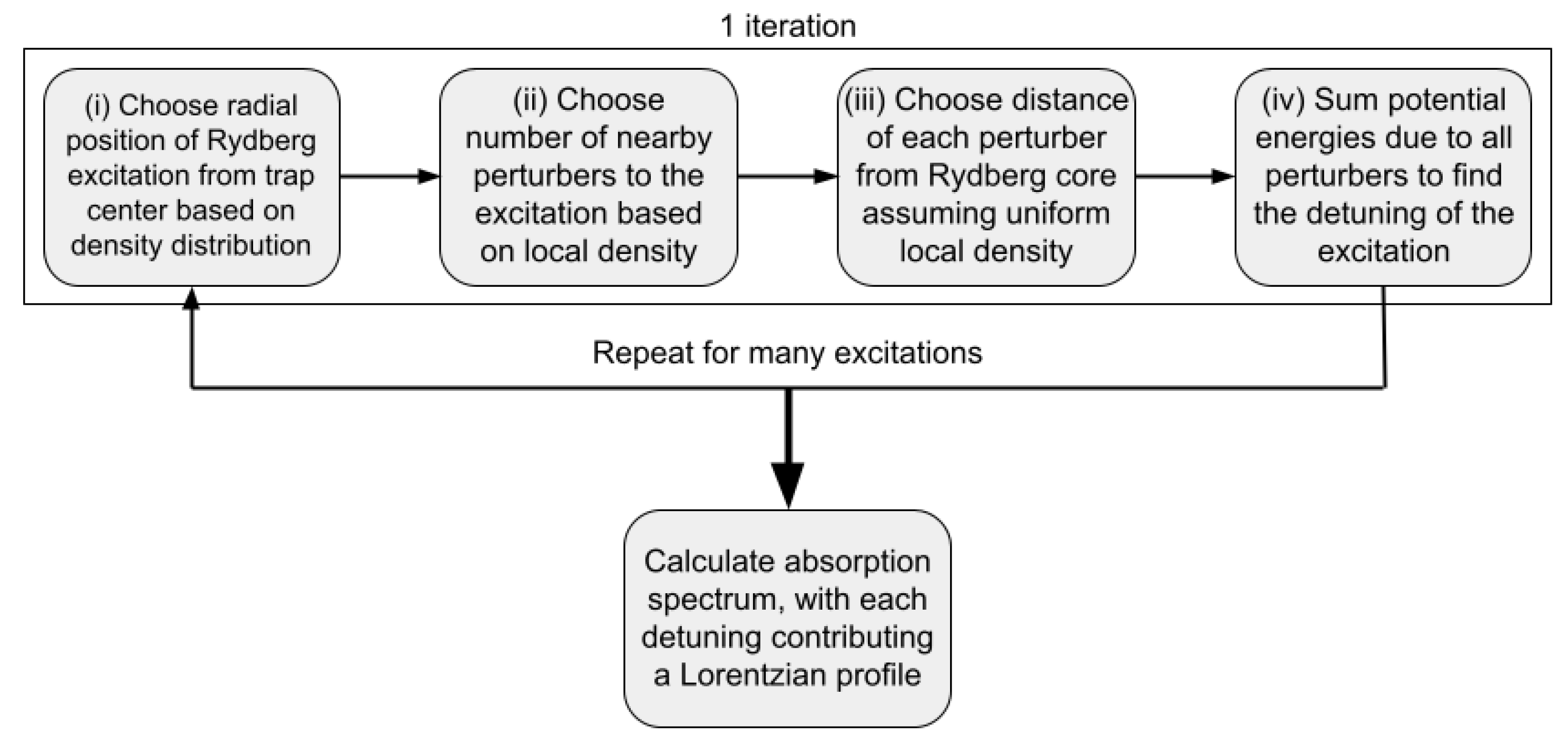
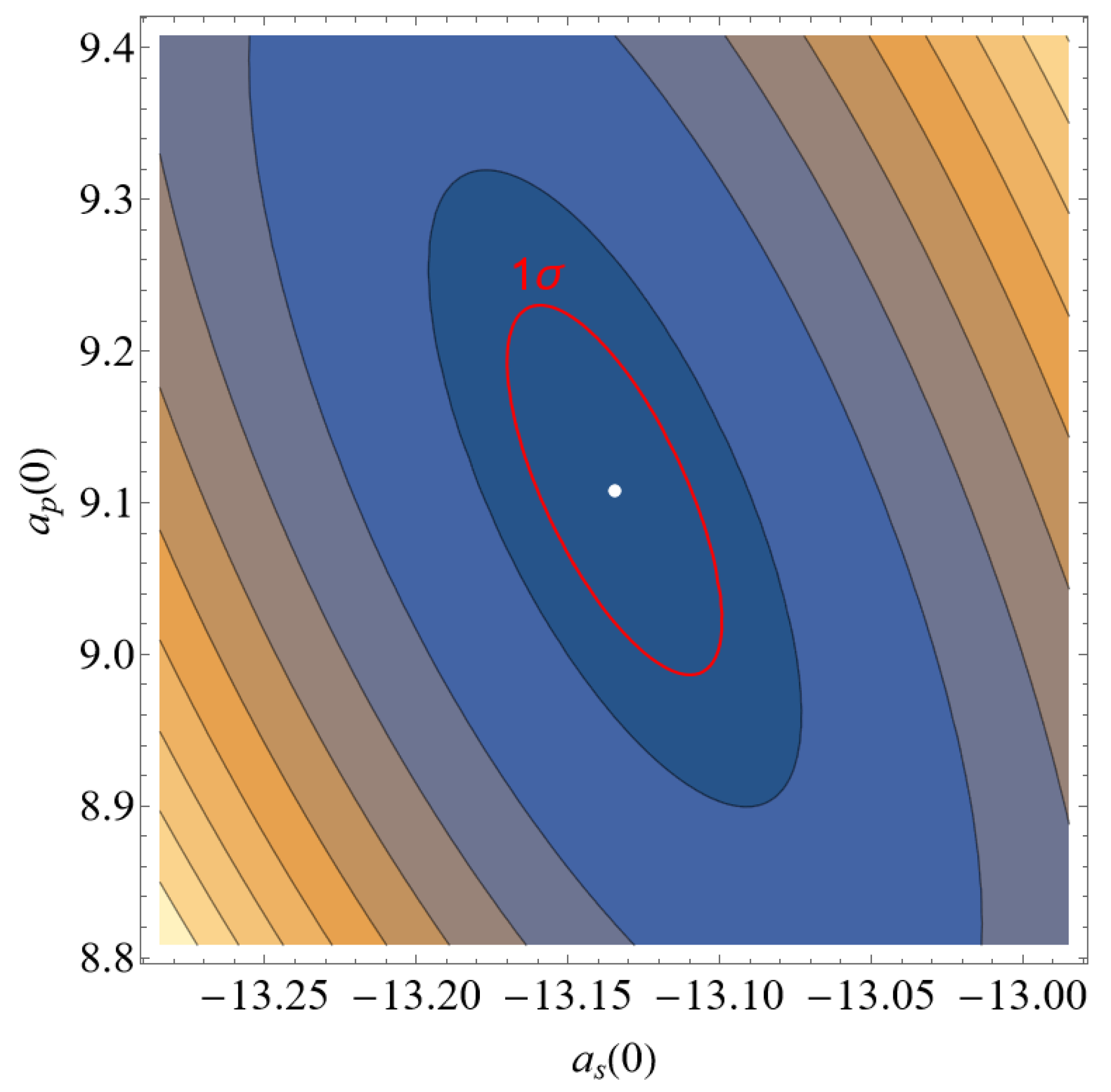
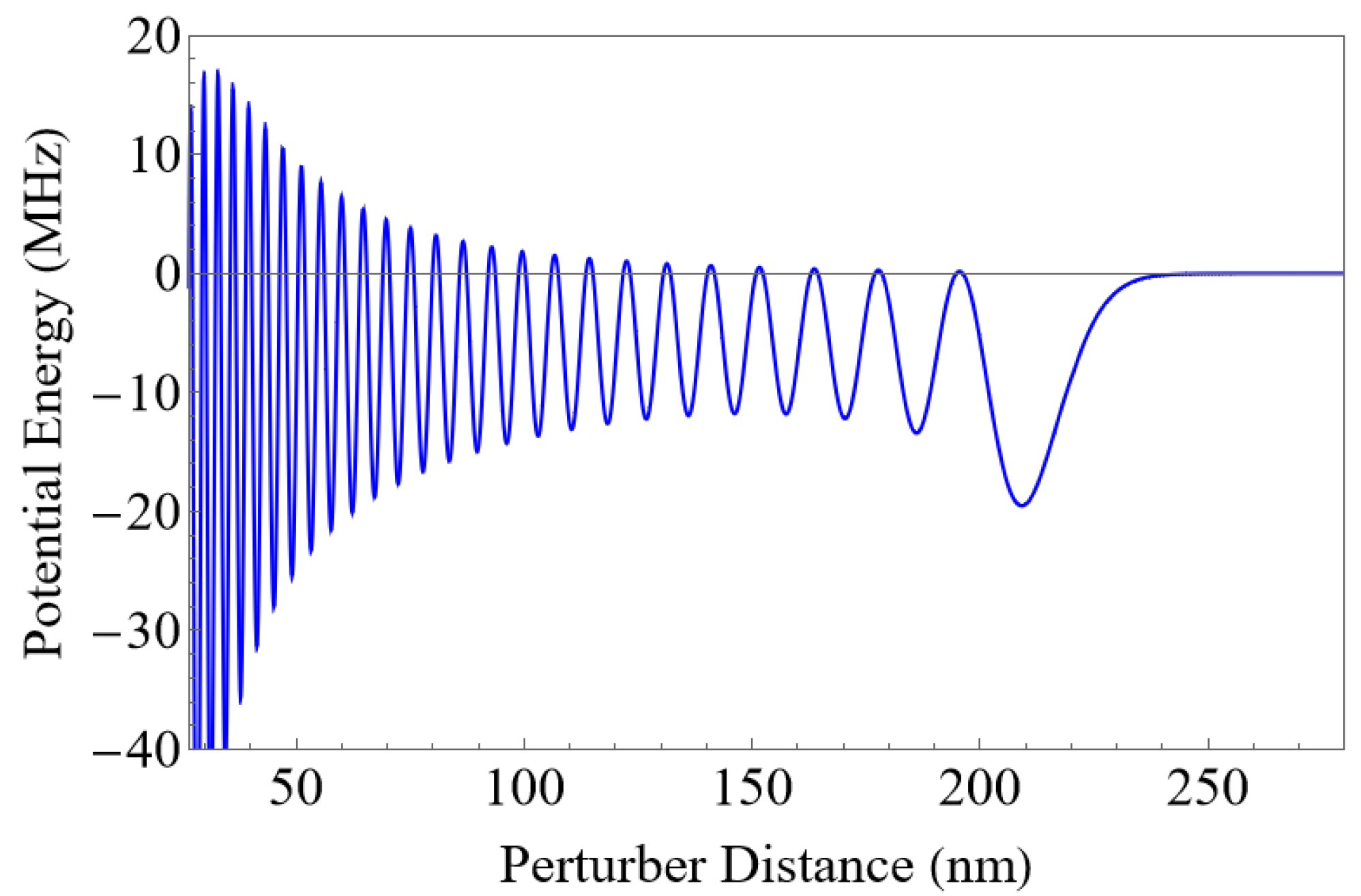
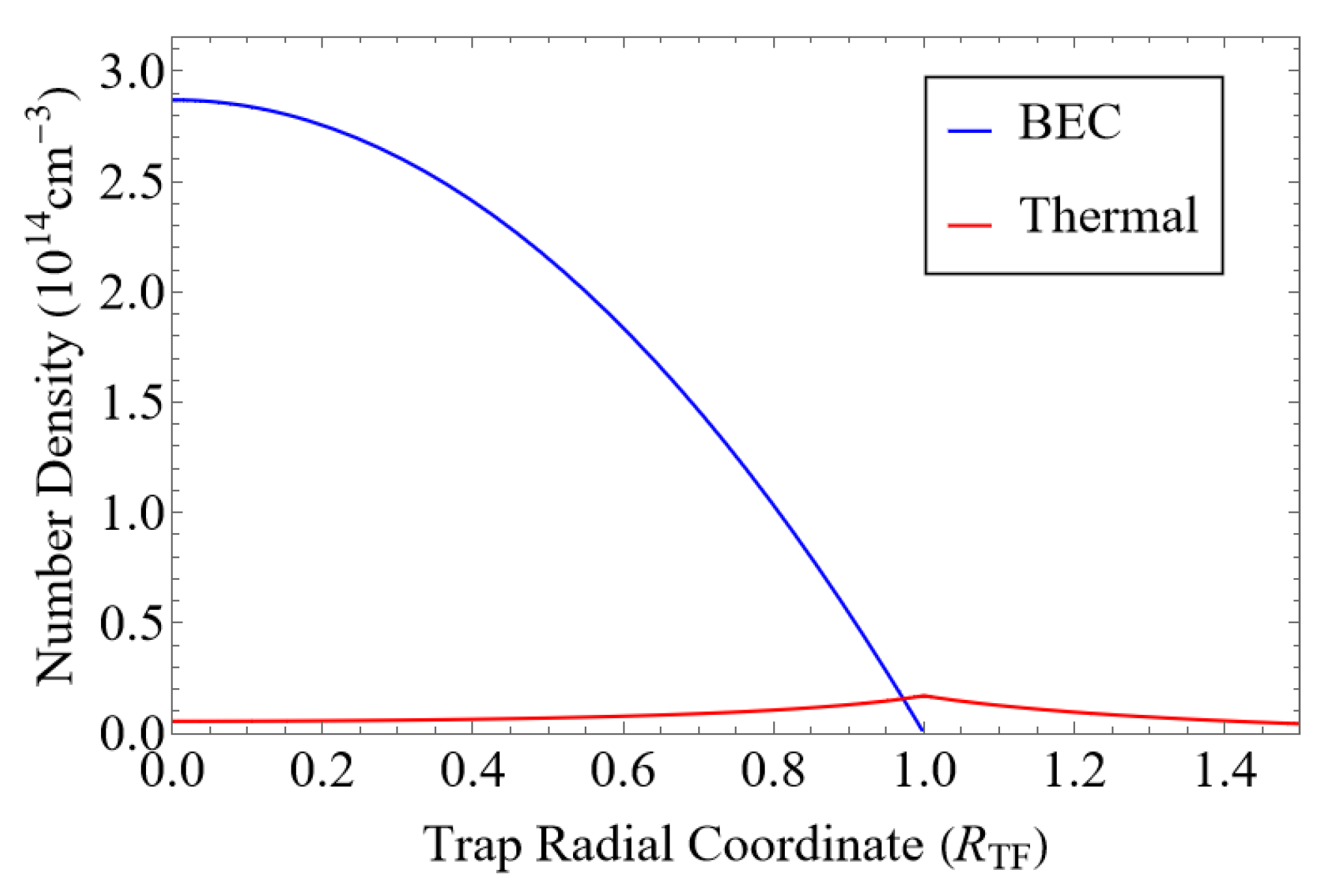
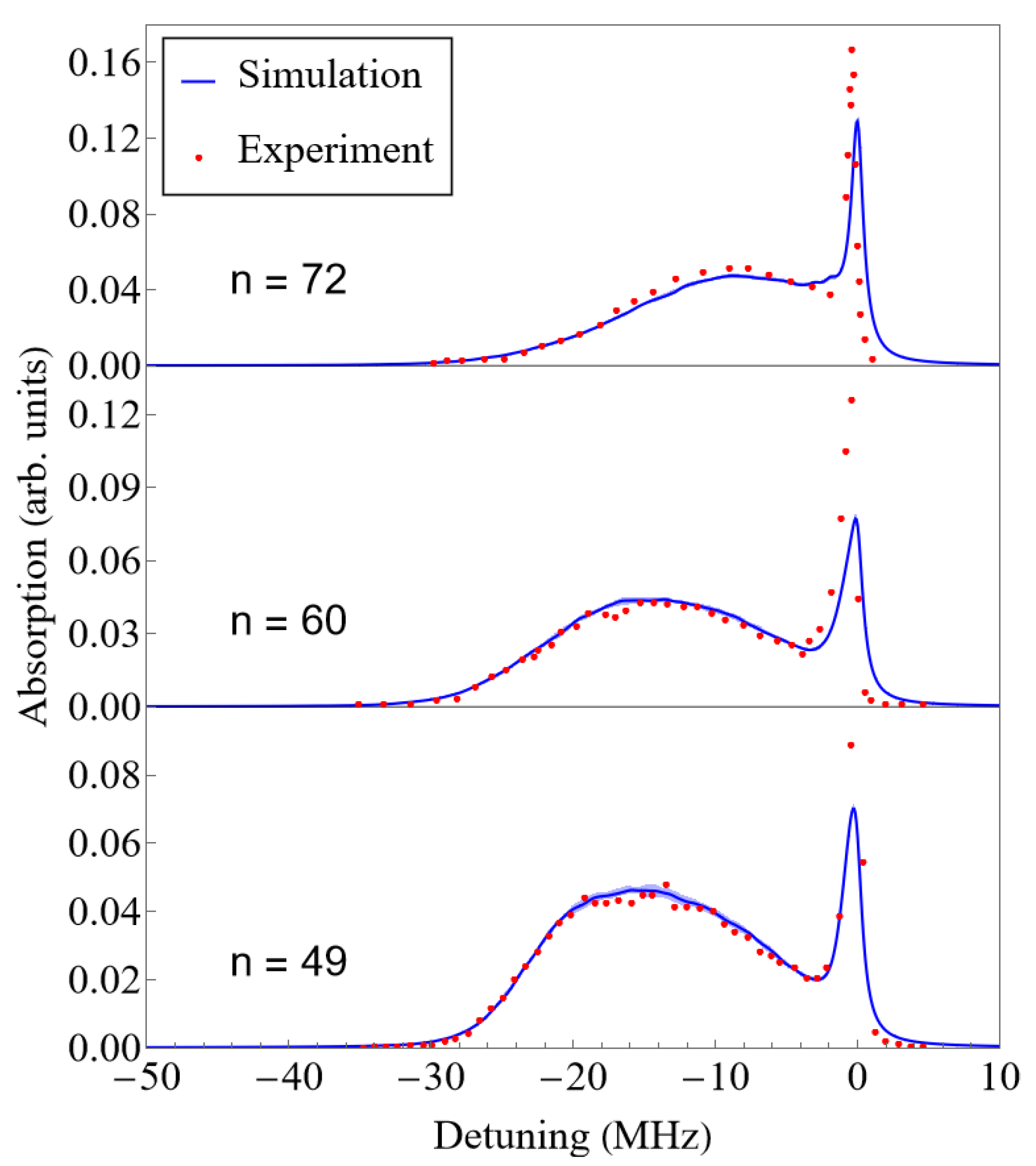
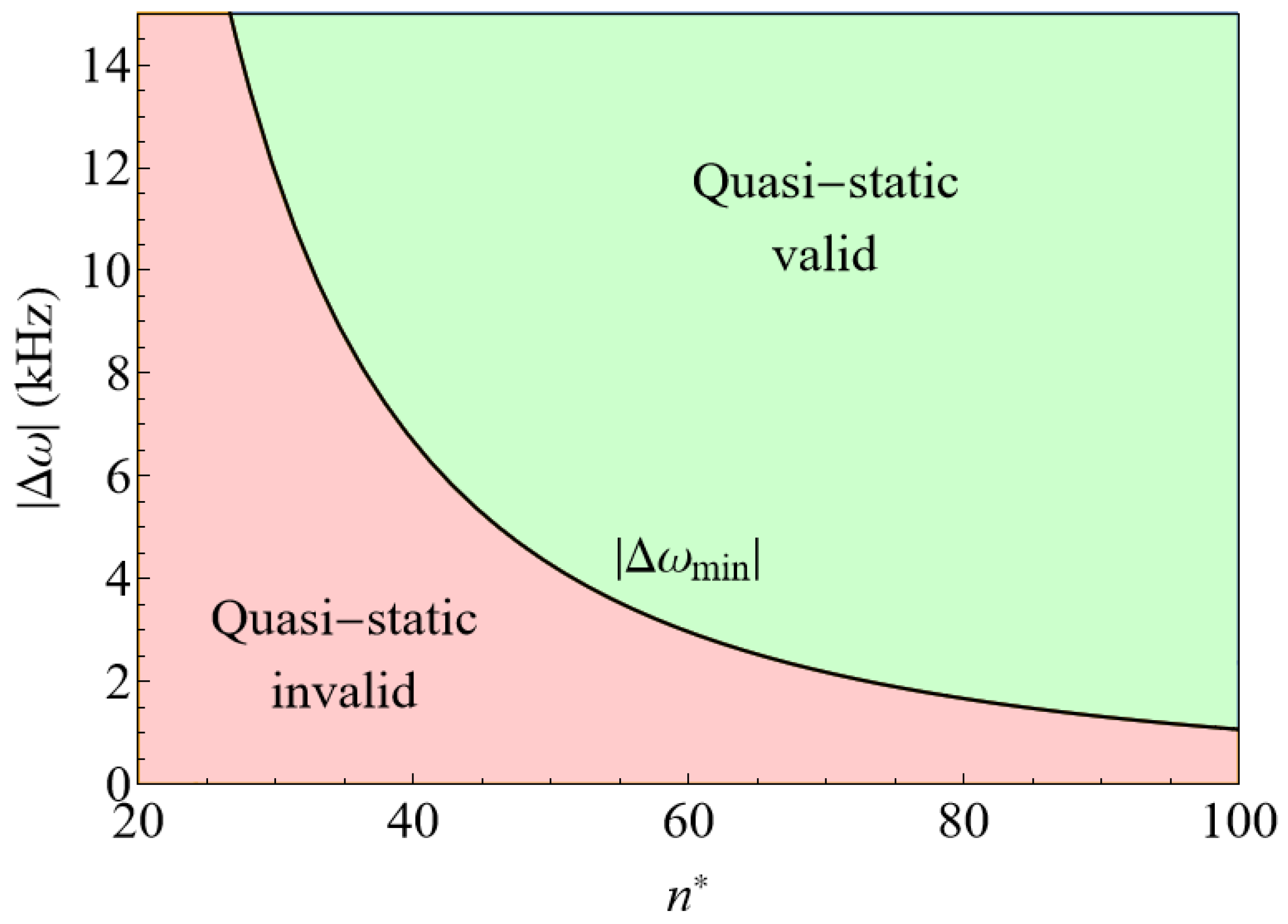
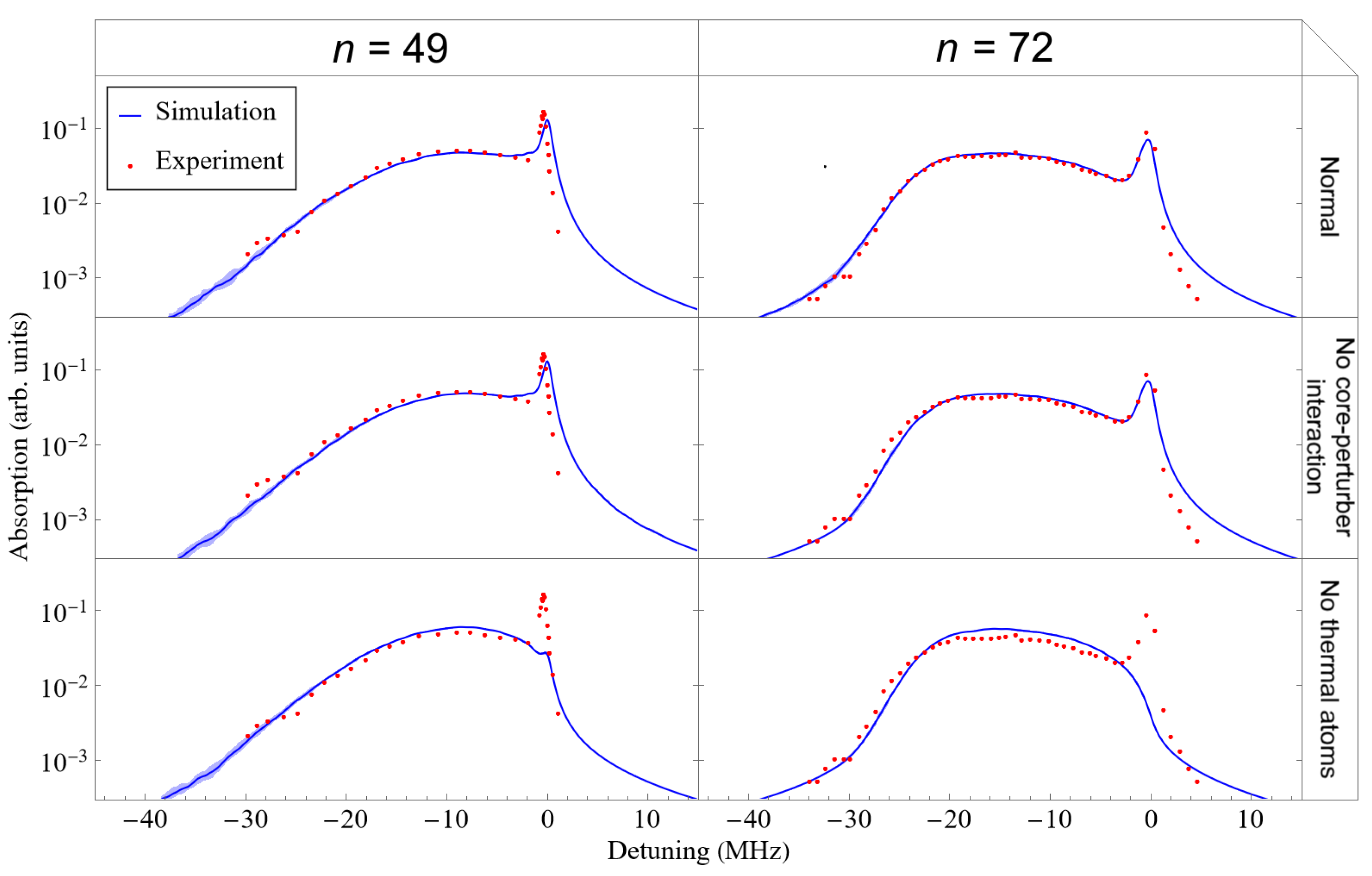
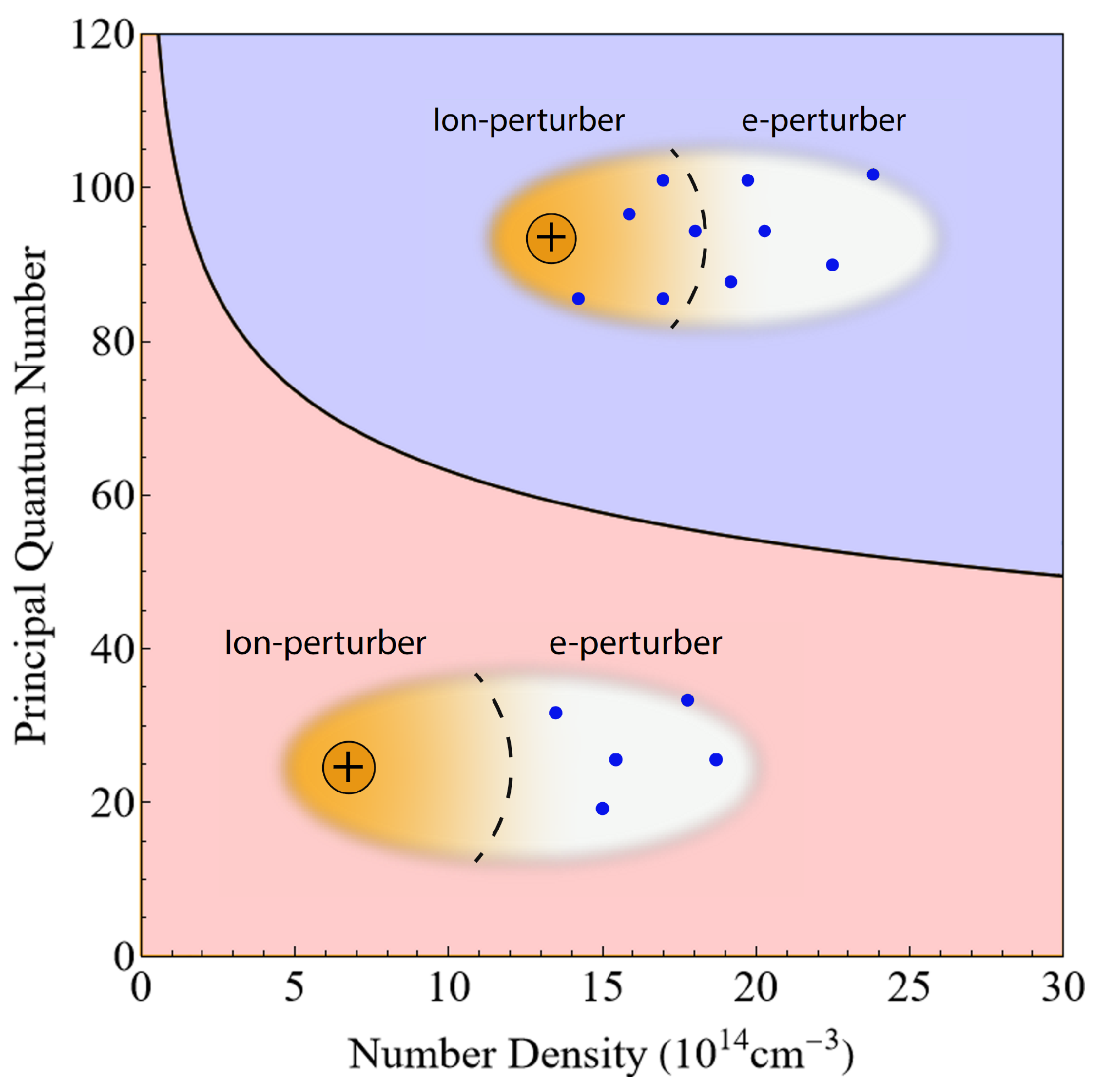
| (a.u.) | m (a.u.) | (a) | (MHz) |
|---|---|---|---|
| 153,123 | 123 | 1 |
Disclaimer/Publisher’s Note: The statements, opinions and data contained in all publications are solely those of the individual author(s) and contributor(s) and not of MDPI and/or the editor(s). MDPI and/or the editor(s) disclaim responsibility for any injury to people or property resulting from any ideas, methods, instructions or products referred to in the content. |
© 2023 by the authors. Licensee MDPI, Basel, Switzerland. This article is an open access article distributed under the terms and conditions of the Creative Commons Attribution (CC BY) license (https://creativecommons.org/licenses/by/4.0/).
Share and Cite
Scheuing, T.; Pérez-Ríos, J. Quasi-Static Lineshape Theory for Rydberg Excitations in High-Density Media. Atoms 2023, 11, 95. https://doi.org/10.3390/atoms11060095
Scheuing T, Pérez-Ríos J. Quasi-Static Lineshape Theory for Rydberg Excitations in High-Density Media. Atoms. 2023; 11(6):95. https://doi.org/10.3390/atoms11060095
Chicago/Turabian StyleScheuing, Trevor, and Jesús Pérez-Ríos. 2023. "Quasi-Static Lineshape Theory for Rydberg Excitations in High-Density Media" Atoms 11, no. 6: 95. https://doi.org/10.3390/atoms11060095
APA StyleScheuing, T., & Pérez-Ríos, J. (2023). Quasi-Static Lineshape Theory for Rydberg Excitations in High-Density Media. Atoms, 11(6), 95. https://doi.org/10.3390/atoms11060095






